Andrew Poulton
Jack
Command A: An Enterprise-Ready Large Language Model
Apr 01, 2025Abstract:In this report we describe the development of Command A, a powerful large language model purpose-built to excel at real-world enterprise use cases. Command A is an agent-optimised and multilingual-capable model, with support for 23 languages of global business, and a novel hybrid architecture balancing efficiency with top of the range performance. It offers best-in-class Retrieval Augmented Generation (RAG) capabilities with grounding and tool use to automate sophisticated business processes. These abilities are achieved through a decentralised training approach, including self-refinement algorithms and model merging techniques. We also include results for Command R7B which shares capability and architectural similarities to Command A. Weights for both models have been released for research purposes. This technical report details our original training pipeline and presents an extensive evaluation of our models across a suite of enterprise-relevant tasks and public benchmarks, demonstrating excellent performance and efficiency.
Evaluation data contamination in LLMs: how do we measure it and (when) does it matter?
Nov 06, 2024Abstract:Hampering the interpretation of benchmark scores, evaluation data contamination has become a growing concern in the evaluation of LLMs, and an active area of research studies its effects. While evaluation data contamination is easily understood intuitively, it is surprisingly difficult to define precisely which samples should be considered contaminated and, consequently, how it impacts benchmark scores. We propose that these questions should be addressed together and that contamination metrics can be assessed based on whether models benefit from the examples they mark contaminated. We propose a novel analysis method called ConTAM, and show with a large scale survey of existing and novel n-gram based contamination metrics across 13 benchmarks and 7 models from 2 different families that ConTAM can be used to better understand evaluation data contamination and its effects. We find that contamination may have a much larger effect than reported in recent LLM releases and benefits models differently at different scales. We also find that considering only the longest contaminated substring provides a better signal than considering a union of all contaminated substrings, and that doing model and benchmark specific threshold analysis greatly increases the specificity of the results. Lastly, we investigate the impact of hyperparameter choices, finding that, among other things, both using larger values of n and disregarding matches that are infrequent in the pre-training data lead to many false negatives. With ConTAM, we provide a method to empirically ground evaluation data contamination metrics in downstream effects. With our exploration, we shed light on how evaluation data contamination can impact LLMs and provide insight into the considerations important when doing contamination analysis. We end our paper by discussing these in more detail and providing concrete suggestions for future work.
The Llama 3 Herd of Models
Jul 31, 2024Abstract:Modern artificial intelligence (AI) systems are powered by foundation models. This paper presents a new set of foundation models, called Llama 3. It is a herd of language models that natively support multilinguality, coding, reasoning, and tool usage. Our largest model is a dense Transformer with 405B parameters and a context window of up to 128K tokens. This paper presents an extensive empirical evaluation of Llama 3. We find that Llama 3 delivers comparable quality to leading language models such as GPT-4 on a plethora of tasks. We publicly release Llama 3, including pre-trained and post-trained versions of the 405B parameter language model and our Llama Guard 3 model for input and output safety. The paper also presents the results of experiments in which we integrate image, video, and speech capabilities into Llama 3 via a compositional approach. We observe this approach performs competitively with the state-of-the-art on image, video, and speech recognition tasks. The resulting models are not yet being broadly released as they are still under development.
Quantifying Variance in Evaluation Benchmarks
Jun 14, 2024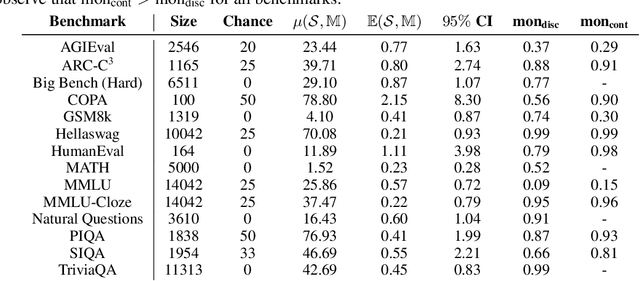
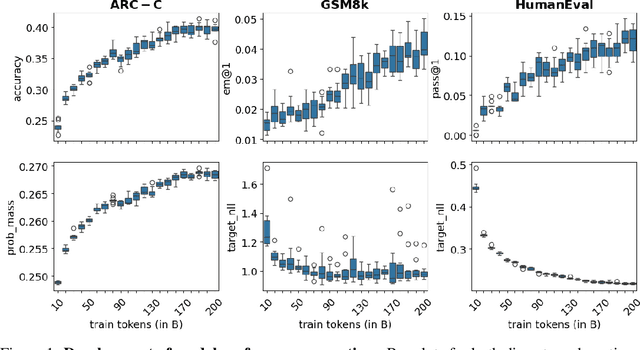

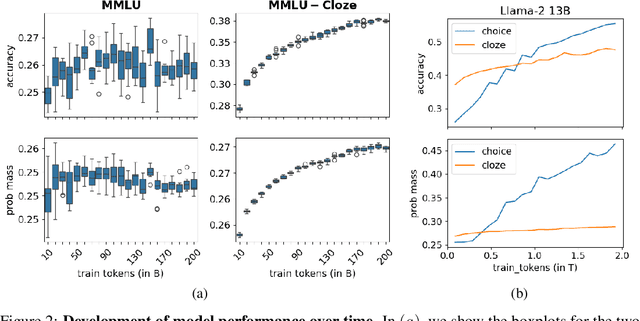
Abstract:Evaluation benchmarks are the cornerstone of measuring capabilities of large language models (LLMs), as well as driving progress in said capabilities. Originally designed to make claims about capabilities (or lack thereof) in fully pretrained models, evaluation benchmarks are now also extensively used to decide between various training choices. Despite this widespread usage, we rarely quantify the variance in our evaluation benchmarks, which dictates whether differences in performance are meaningful. Here, we define and measure a range of metrics geared towards measuring variance in evaluation benchmarks, including seed variance across initialisations, and monotonicity during training. By studying a large number of models -- both openly available and pretrained from scratch -- we provide empirical estimates for a variety of variance metrics, with considerations and recommendations for practitioners. We also evaluate the utility and tradeoffs of continuous versus discrete performance measures and explore options for better understanding and reducing this variance. We find that simple changes, such as framing choice tasks (like MMLU) as completion tasks, can often reduce variance for smaller scale ($\sim$7B) models, while more involved methods inspired from human testing literature (such as item analysis and item response theory) struggle to meaningfully reduce variance. Overall, our work provides insights into variance in evaluation benchmarks, suggests LM-specific techniques to reduce variance, and more generally encourages practitioners to carefully factor in variance when comparing models.
Llama 2: Open Foundation and Fine-Tuned Chat Models
Jul 19, 2023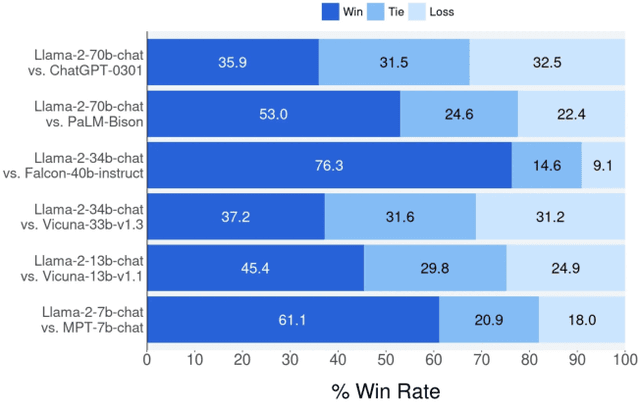

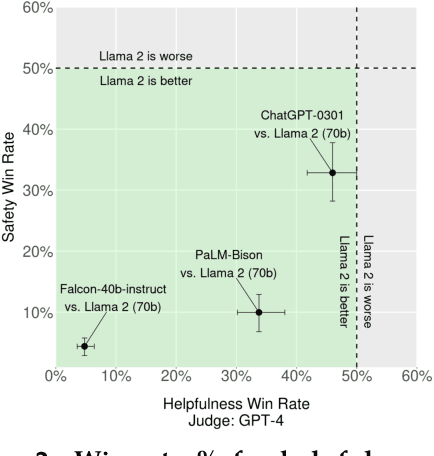

Abstract:In this work, we develop and release Llama 2, a collection of pretrained and fine-tuned large language models (LLMs) ranging in scale from 7 billion to 70 billion parameters. Our fine-tuned LLMs, called Llama 2-Chat, are optimized for dialogue use cases. Our models outperform open-source chat models on most benchmarks we tested, and based on our human evaluations for helpfulness and safety, may be a suitable substitute for closed-source models. We provide a detailed description of our approach to fine-tuning and safety improvements of Llama 2-Chat in order to enable the community to build on our work and contribute to the responsible development of LLMs.
A Theory on Adam Instability in Large-Scale Machine Learning
Apr 25, 2023



Abstract:We present a theory for the previously unexplained divergent behavior noticed in the training of large language models. We argue that the phenomenon is an artifact of the dominant optimization algorithm used for training, called Adam. We observe that Adam can enter a state in which the parameter update vector has a relatively large norm and is essentially uncorrelated with the direction of descent on the training loss landscape, leading to divergence. This artifact is more likely to be observed in the training of a deep model with a large batch size, which is the typical setting of large-scale language model training. To argue the theory, we present observations from the training runs of the language models of different scales: 7 billion, 30 billion, 65 billion, and 546 billion parameters.
Galactica: A Large Language Model for Science
Nov 16, 2022Abstract:Information overload is a major obstacle to scientific progress. The explosive growth in scientific literature and data has made it ever harder to discover useful insights in a large mass of information. Today scientific knowledge is accessed through search engines, but they are unable to organize scientific knowledge alone. In this paper we introduce Galactica: a large language model that can store, combine and reason about scientific knowledge. We train on a large scientific corpus of papers, reference material, knowledge bases and many other sources. We outperform existing models on a range of scientific tasks. On technical knowledge probes such as LaTeX equations, Galactica outperforms the latest GPT-3 by 68.2% versus 49.0%. Galactica also performs well on reasoning, outperforming Chinchilla on mathematical MMLU by 41.3% to 35.7%, and PaLM 540B on MATH with a score of 20.4% versus 8.8%. It also sets a new state-of-the-art on downstream tasks such as PubMedQA and MedMCQA dev of 77.6% and 52.9%. And despite not being trained on a general corpus, Galactica outperforms BLOOM and OPT-175B on BIG-bench. We believe these results demonstrate the potential for language models as a new interface for science. We open source the model for the benefit of the scientific community.
 Add to Chrome
Add to Chrome Add to Firefox
Add to Firefox Add to Edge
Add to Edge